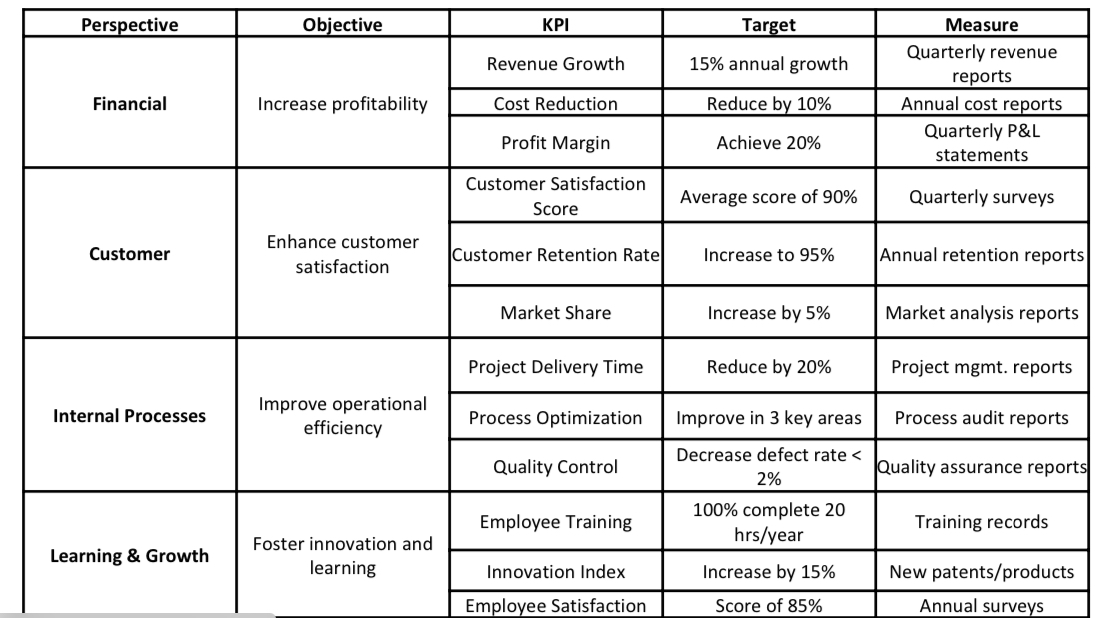CHAPTER 2: STRATEGIC E-MARKETING (copy)
1/73
There's no tags or description
Looks like no tags are added yet.
Name | Mastery | Learn | Test | Matching | Spaced |
|---|
No study sessions yet.
74 Terms
Strategic planning
is a managerial process to develop and maintain a viable fit between the organization’s objectives, skills & resources and its changing market opportunities
(Kotler, 2003).
Strategic planning identifies firm’s goals for:
Growth
Competitive position
Geographic scope
Other objectives, such as industry, products, etc.
The e-marketing plan flows from
the organization’s overall goals and strategies.
The ESP framework illustrates the relationships among …
environment, strategy, and performance.
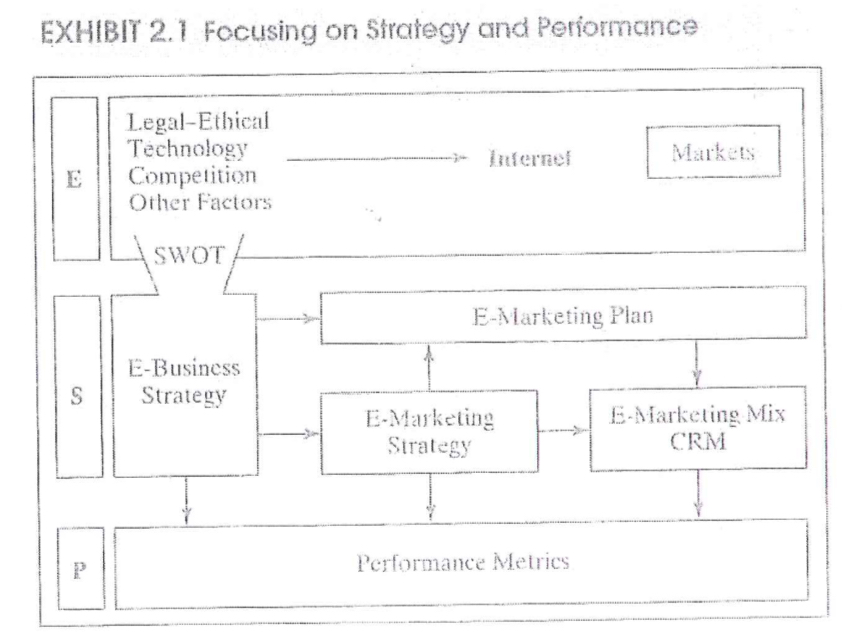
A SWOT analysis of the business environment (E) leads to
the development of strategy (S) and the measurement of performance (P)
Strategy
The means to achieve a goal
Has its roots in military action (strategy to deploy troops)
Functional areas within a firm also develop goals, strategies, and tactics to support
corporate-level objectives.
E-business strategy
Strategy that deploys enterprise resources to capitalize on technologies to reach performance objectives, competitive advantages.
when corporate-level (also called enterprise-level) business strategies include information technology components (Internet, digital data, databases, …), they become …
e-business strategies.
E-marketing strategy
Strategy that capitalizes on the organization’s electronic or information technology capabilities to reach marketing objectives.
Most strategic plans explain the rationale for the chosen objectives and strategies.
Kalakota and Robinson (1999) suggest four appropriate types of rationale:
Strategic justification shows how the strategy fits with the firm's overall mission and business objectives.
Operational justification identifies and quantifies the specific process improvements that will result from the strategy. For example, if CRM (customer relationship management) software is proposed, how will that translate to increased customer retention and higher revenues?
Technical justification shows how the technology will fit and provide synergy with current information technology capabilities. For example, is there interoperability along the currently integrated supply chain.
Financial justification examines cost/benefit analysis and uses standard measures such as return on investment (ROI) and net present value (NPV).
a business model is
a method by which the organization sustains itself in the long term
It includes value proposition for partners and customers as well as its revenue streams.
A firm will select …to accomplish enterprise goals.
one or more business models as strategies
Components of business model selections:
Customer Value: Does the product offer something unique compared to competitors?
Scope: Which markets are served? Are they growing or high-risk new ones?
Price: Are products priced to appeal to customers while meeting profit goals?
Revenue Sources: Are income streams sufficient for long-term growth and profit?
Connected Activities: What key activities are needed, and can the firm deliver?
Implementation: Can the firm's systems, people, and culture make the plan work?
Capabilities: Does the firm have the necessary resources to support the model?
Sustainability: Can the model create a lasting competitive advantage?
an e-business model is
a method by which the organization sustains itself in the long term using information technology, which includes its value proposition for partners and customers as well as its revenue streams.
E-business models can use digital data collection and distribution without the …
Internet
For example, when retailers scan products and customer cards at the checkout, these data can become a rich source of knowledge for inventory management and promotional offers-e-marketing without the Internet.
Similarly, when these data are available through the firm's proprietary computer network (intranet), the firm is applying e-marketing without the Internet.
Though emerged from the Internet, e-marketing and e-business models may operate outside the Internet.
marketing concept is
the idea that an organization’s purpose is to satisfy customer wants and needs while achieving its own objectives.
Value
= Benefits - Costs
It includes the customer's perceptions of the product's benefits, specifically its attributes, brand name, and support services.
Information technology
… value by … benefits and … costs for stakeholders.
but can … value if websites are difficult to use.
Increase - increase - reduce
Reduce
Level of commitment to E-Business
As firms move up the pyramid, their commitment to e-business increases, integrating more with IT and impacting the organization.
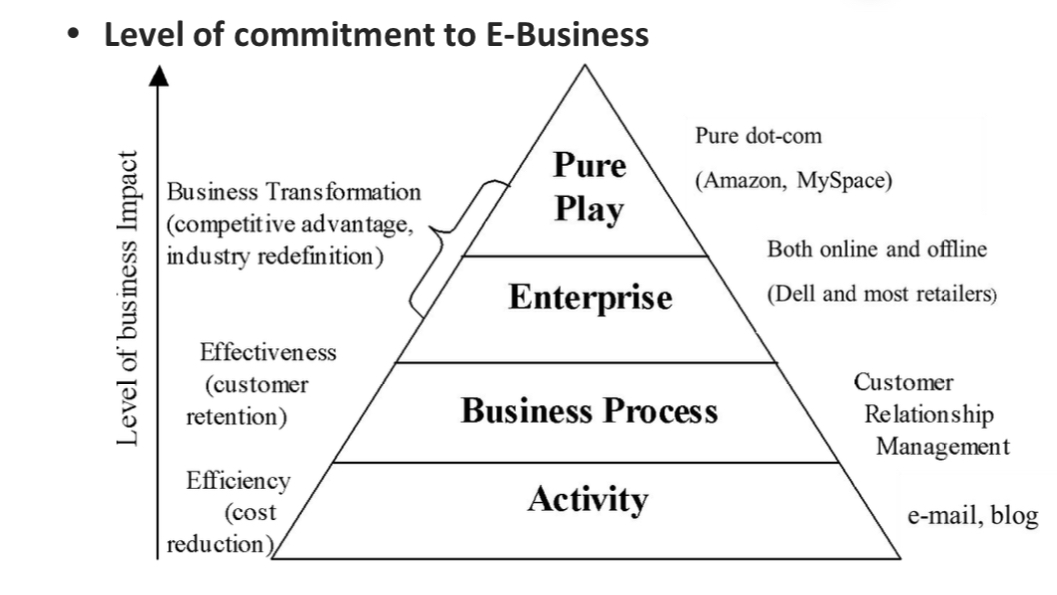
Level of commitment to E-Business
… are at the top,
… ones are at lower levels,
with higher levels carrying more risk.
Strategic decisions
Tactical decisions
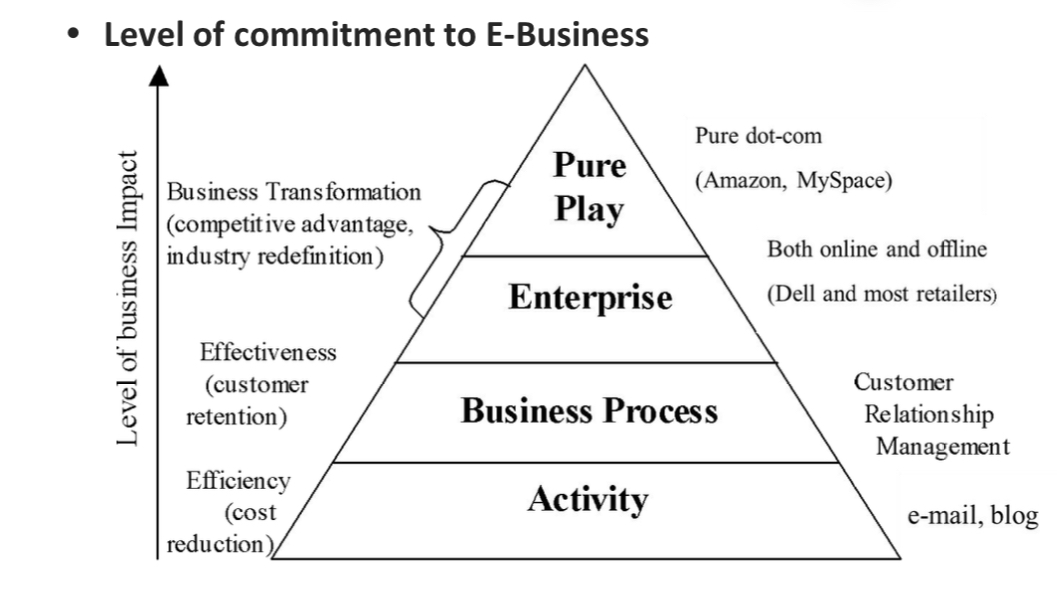
the lowest level of commitment —not shown on the pyramid —is no
e-business involvement.
E.g: Many small businesses, like local retailers and dry cleaners, are at this level and may not benefit much from e-business strategies due to their limited capabilities.
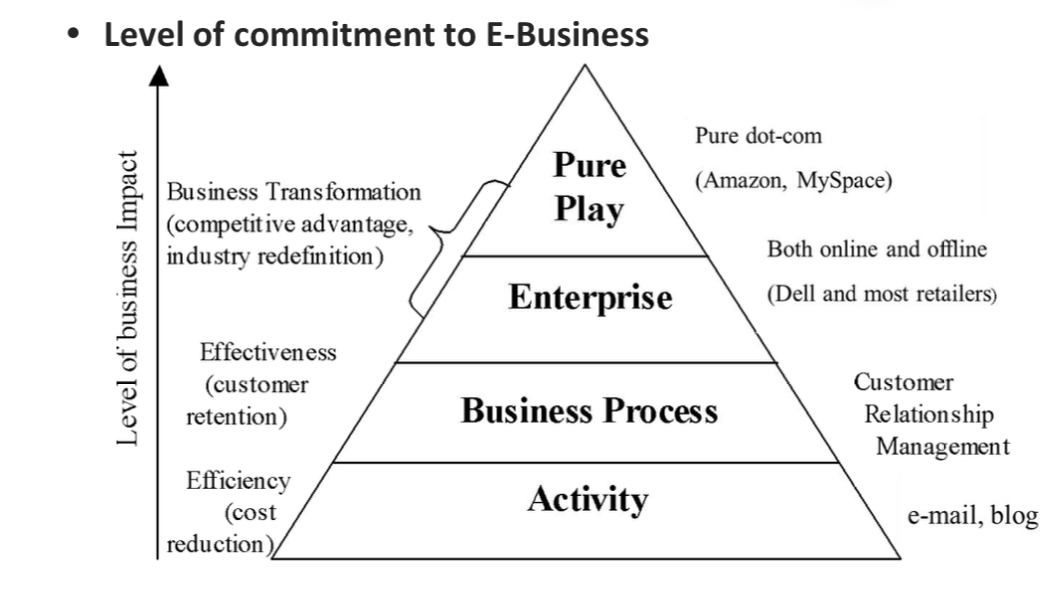
8 components of ACTIVITY-LEVEL MODELS
lowest level of the pyramid
These low-risk e-business models include:
1. Order processing
2. Online purchasing
3. E-mail
4. Content publisher
5. Business intelligence (BI)
6. Online advertising and public relations (PR)
7. Online sales promotions
8. Dynamic pricing strategies online
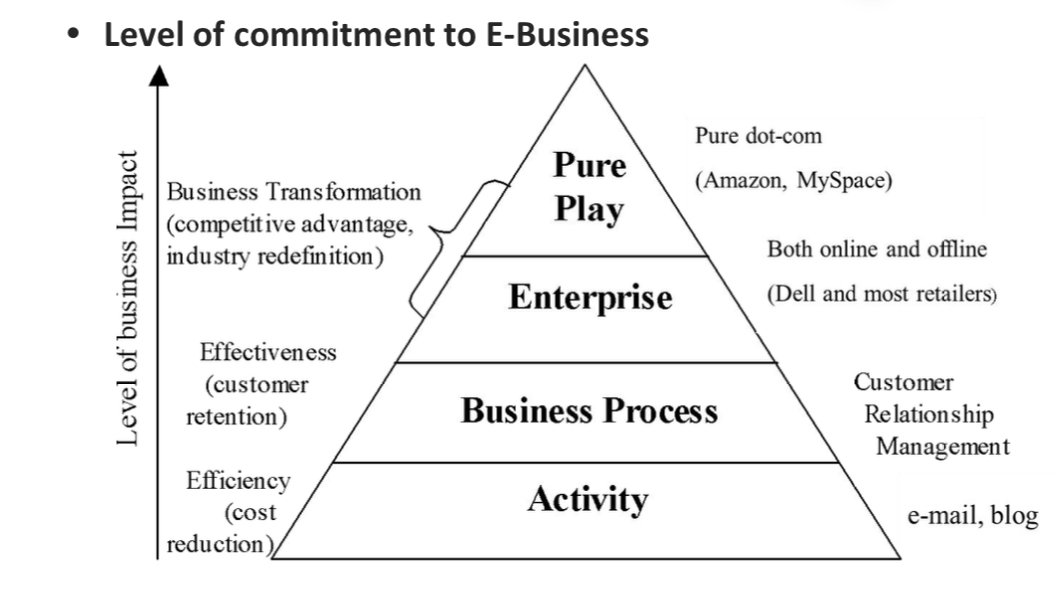
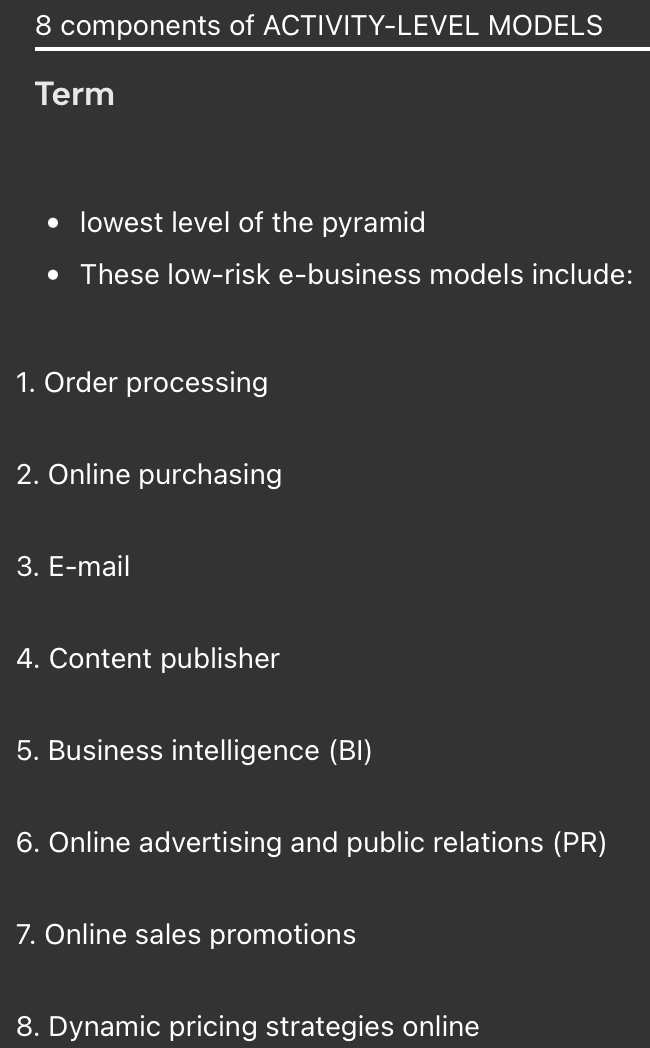
ACTIVITY-LEVEL E-BUSINESS MODELS:
Online Purchasing
Firms can use the Web to place orders with suppliers, thus automating the activity.
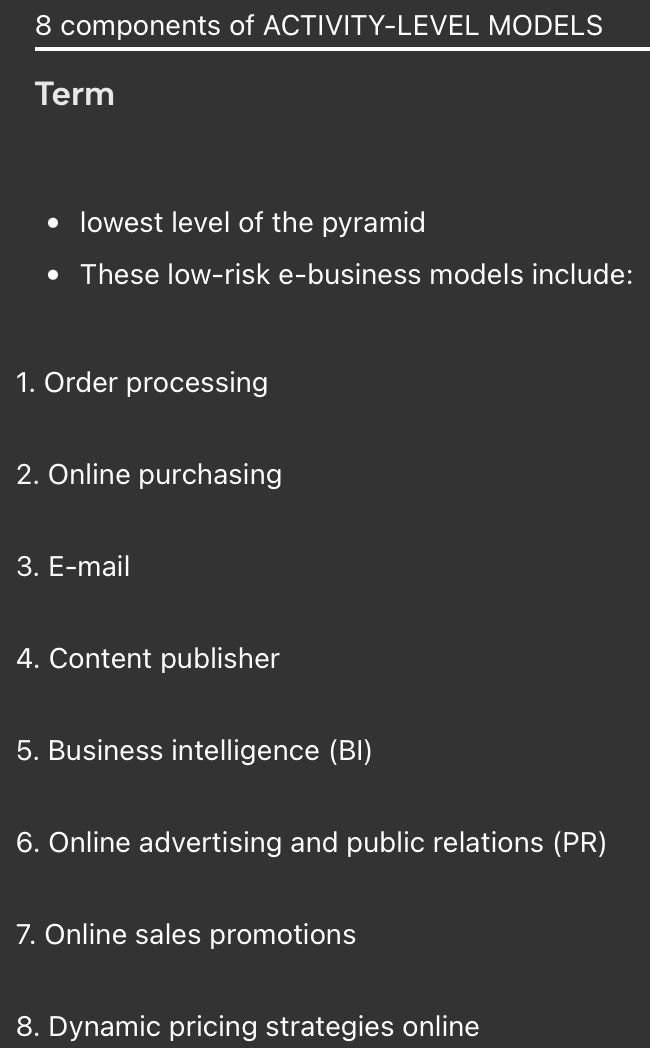
ACTIVITY-LEVEL E-BUSINESS MODELS:
Order Processing
This model occurs when online retailers automate Internet transactions created by customers.
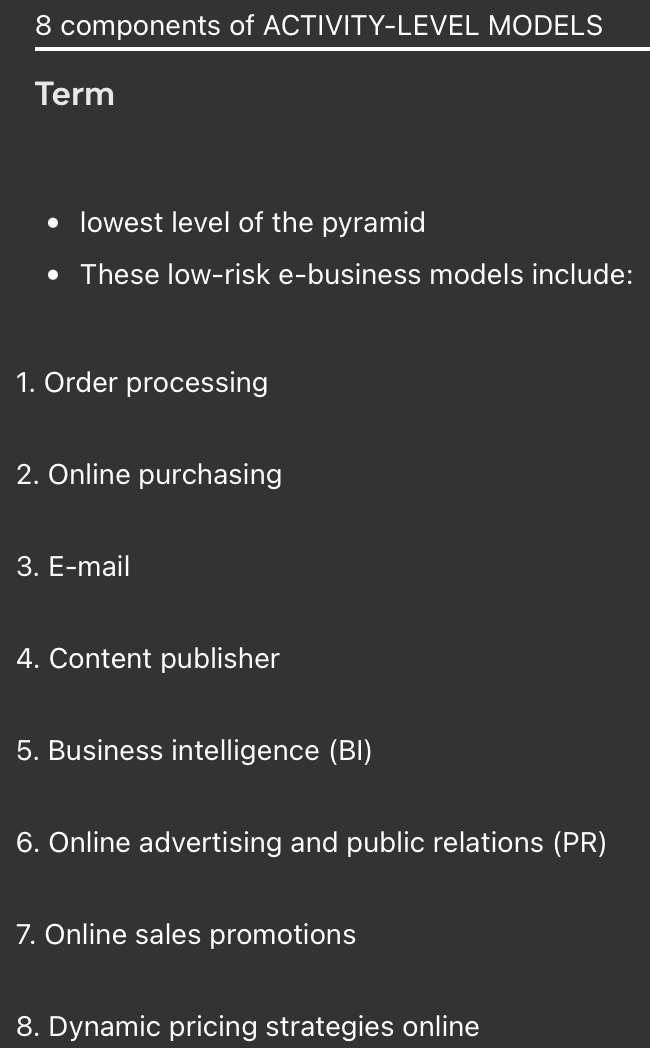
ACTIVITY-LEVEL E-BUSINESS MODELS:
When organizations send e-mail to stakeholders, they save printing and mailing costs.
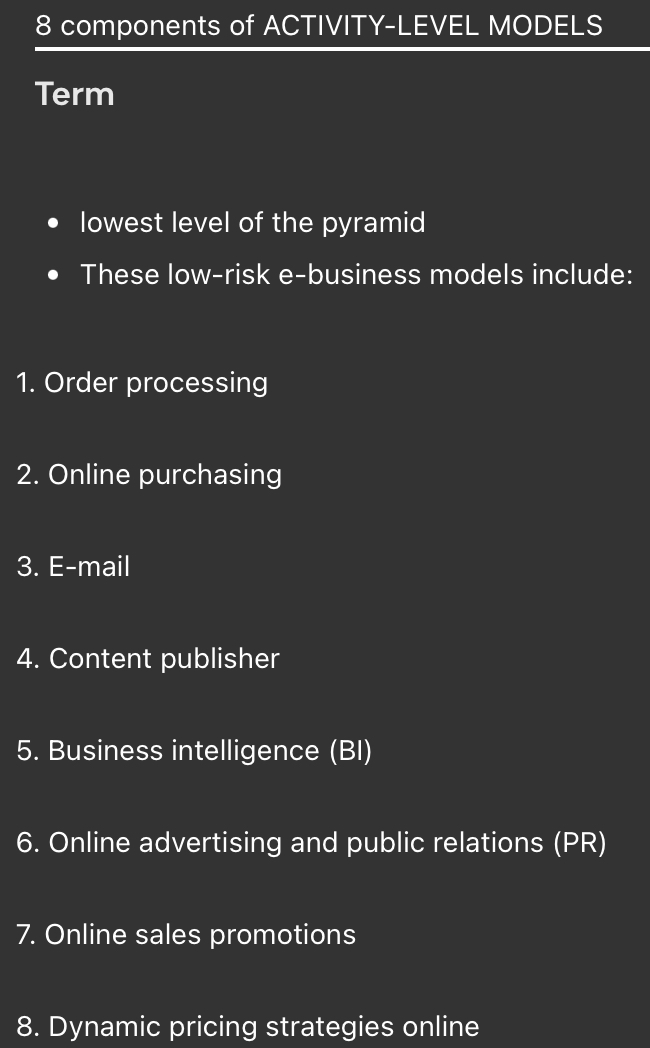
ACTIVITY-LEVEL E-BUSINESS MODELS:
Content publisher
companies create valuable content or services on their Web sites, draw lots of traffic, and sell advertising.
In another type of content publishing, the firm posts information about its offerings on a Web site — dubbed brochureware - thus saving printing costs.
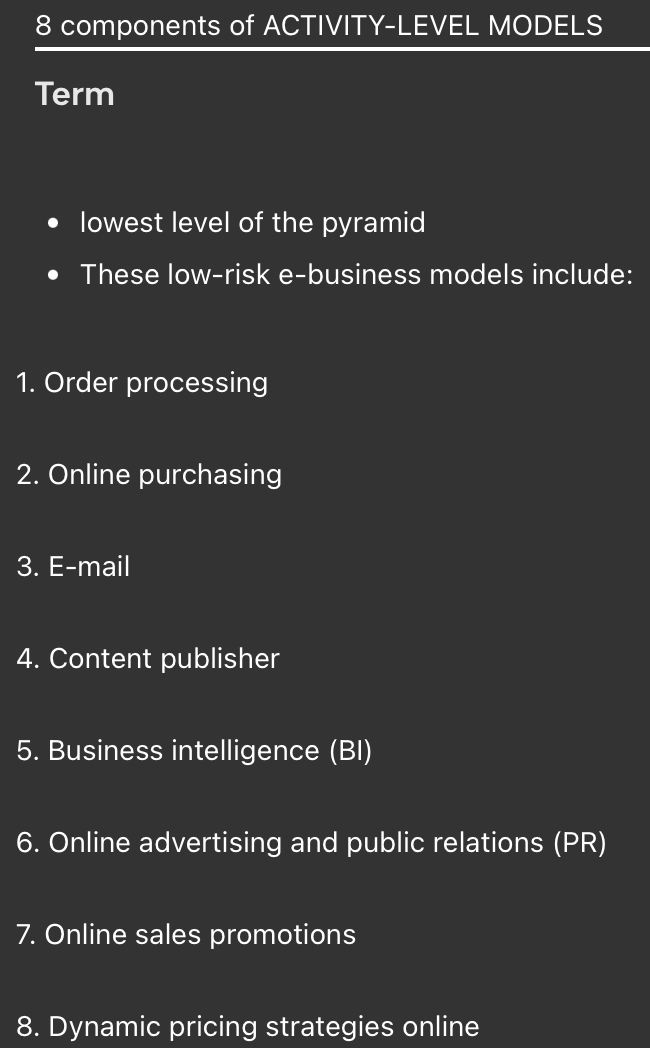
ACTIVITY-LEVEL E-BUSINESS MODELS:
Business intelligence (BI)
This activity refers to the gathering of secondary & primary information about competitors, markets, customers,…
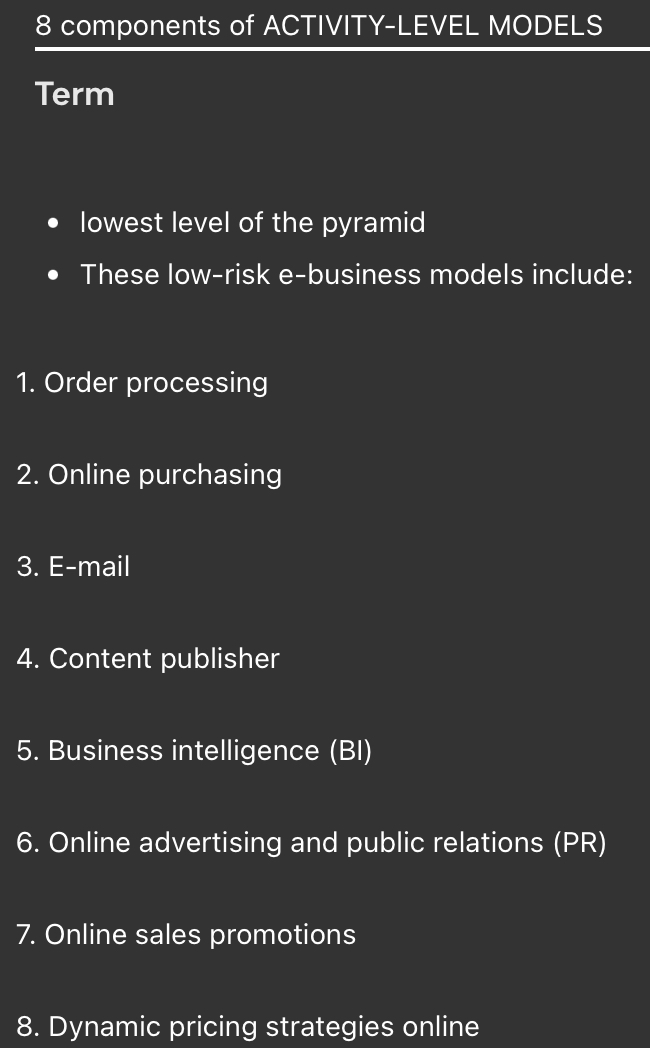
ACTIVITY-LEVEL E-BUSINESS MODELS:
Online advertising
As an activity, the firm buys advertising on someone else's e-mail or Web site.
When the firm sells advertising, it is engaging in content sponsorship, a higher-level process.
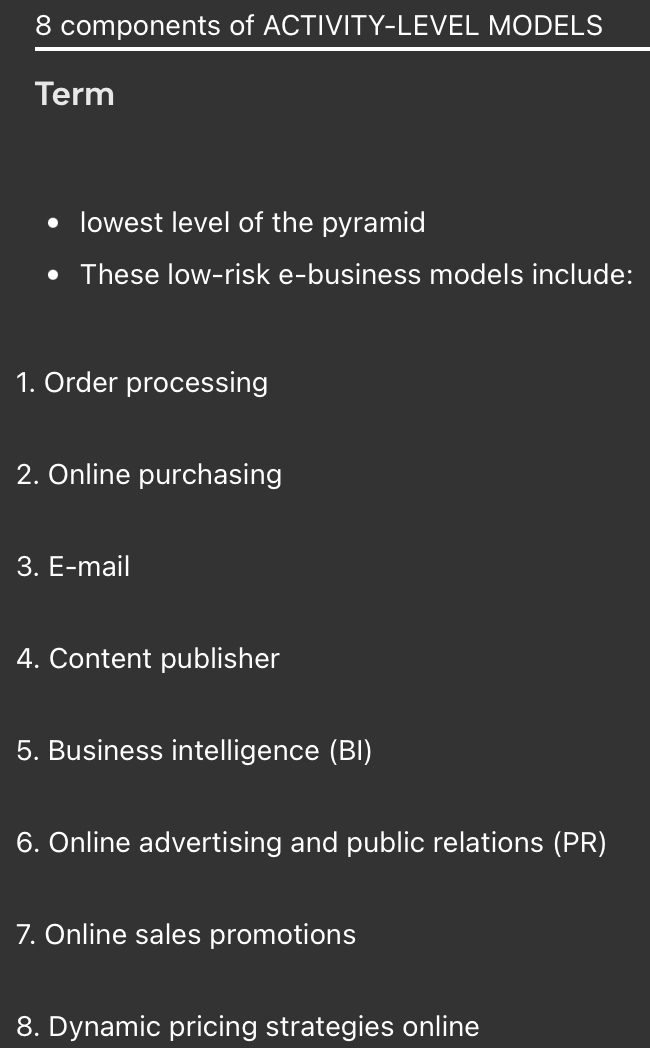
ACTIVITY-LEVEL E-BUSINESS MODELS:
Online sales promotion
Companies use the Internet to send samples of digital products (e.g., music or software) or electronic coupons, among other tactics.
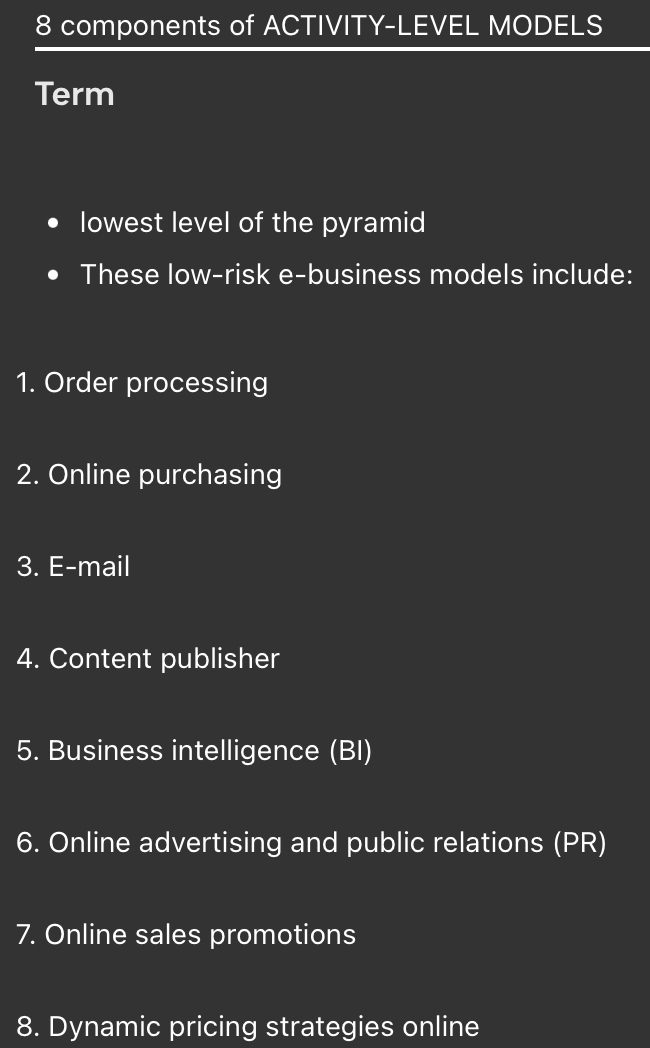
ACTIVITY-LEVEL E-BUSINESS MODELS:
Pricing strategies
With dynamic pricing, a firm presents different prices to various groups of customers, even at the individual level.
Online negotiation through auctions is one type of dynamic pricing initiated by the buyer instead of the seller.
Technology allows this activity to be automated.
Online negotiation through auctions is one type of dynamic pricing initiated by
The buyers, not sellers
7 components of BUSINESS PROCESS-LEVEL MODELS
1. Customer relationship management (CRM)
2. Knowledge management (KM)
3. Supply chain management (SCM)
4. Community building online
5. Database marketing
6. Enterprise resource planning (ERP)
7. Mass customization

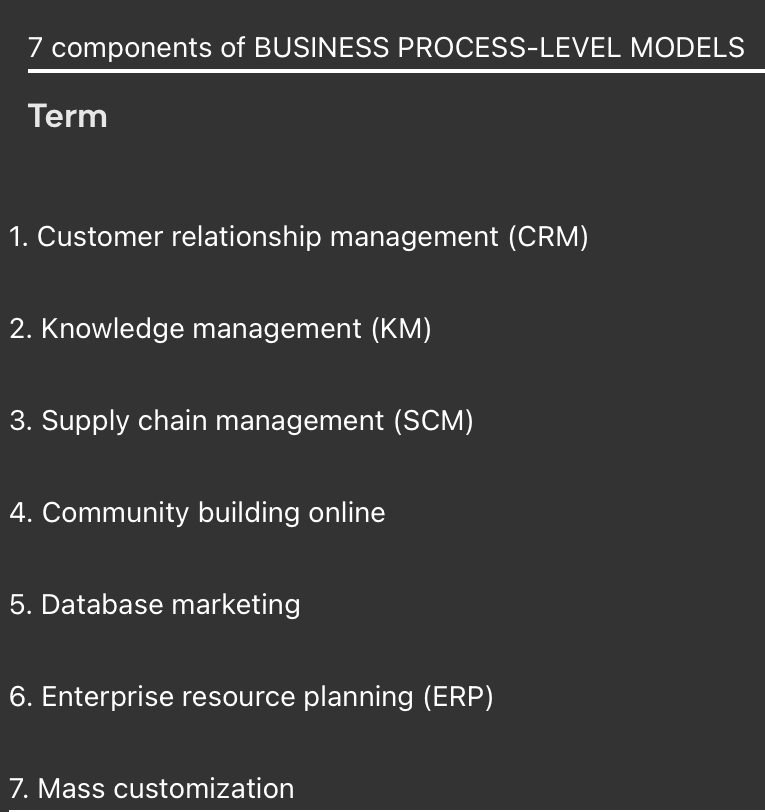
BUSINESS PROCESS-LEVEL MODELS
Customer relationship management (CRM)
It focuses on retaining and growing customers by ensuring their satisfaction with the firm and its products.
It aims for long-term relationships and increased transaction frequency.
CRM uses digital processes and integrates customer information collected at every customer’s …
touch point
Customers interact with firms in person at retail stores or company offices, by mail, via telephone, or over the Internet.
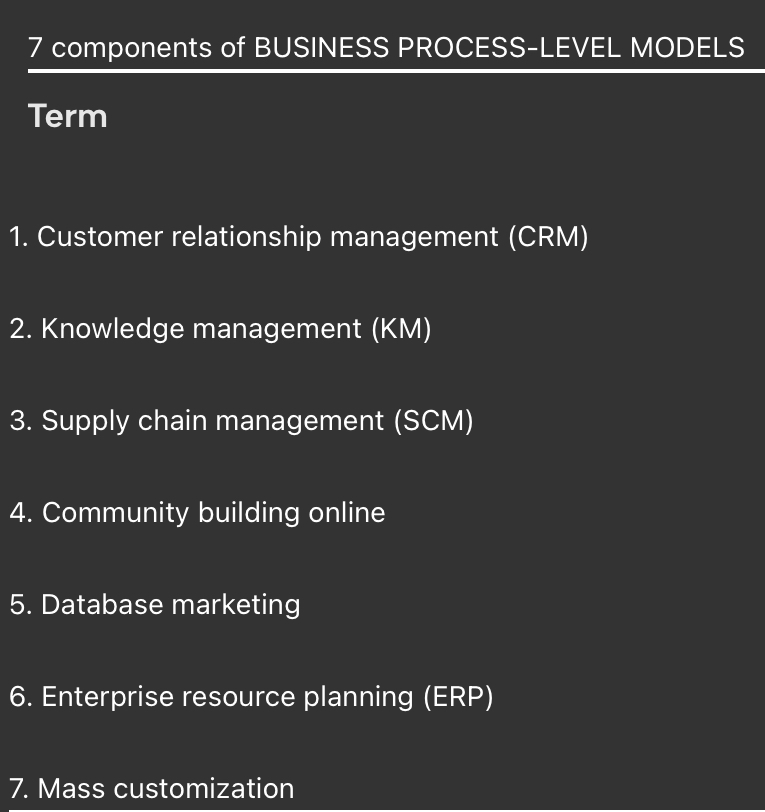
BUSINESS PROCESS-LEVEL MODELS
Knowledge management (KM)
a combination of a firm's database contents. the technology used to create the system, and the transformation of data into useful information and knowledge.
Act as a storehouse of reports, customer account information, product sales, … that managers can use to make decisions.
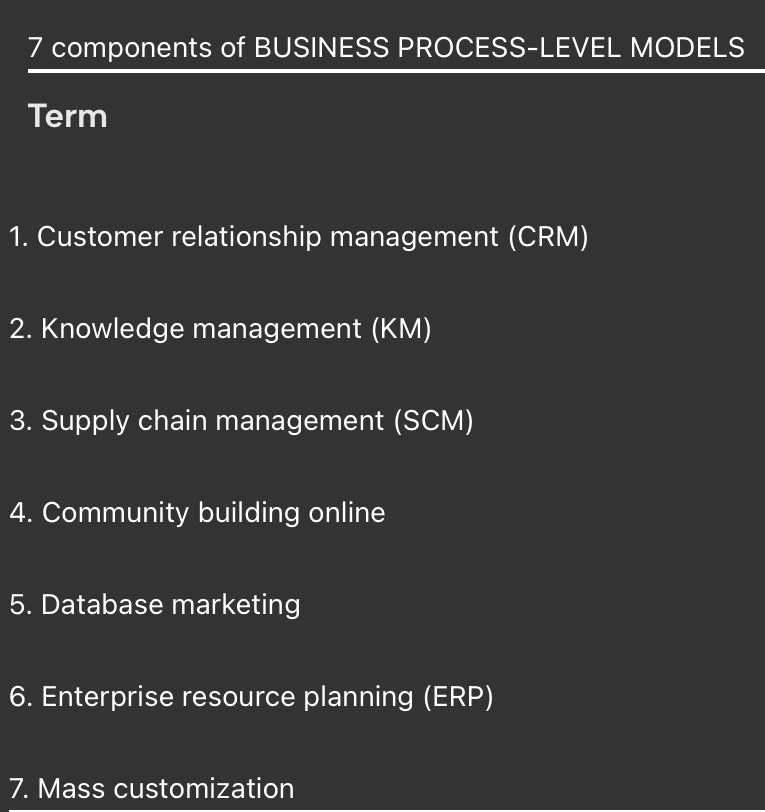
BUSINESS PROCESS-LEVEL MODELS
Supply chain management (SCM)
involves coordination of the distribution channel to deliver products more effectively and efficiently to customers.
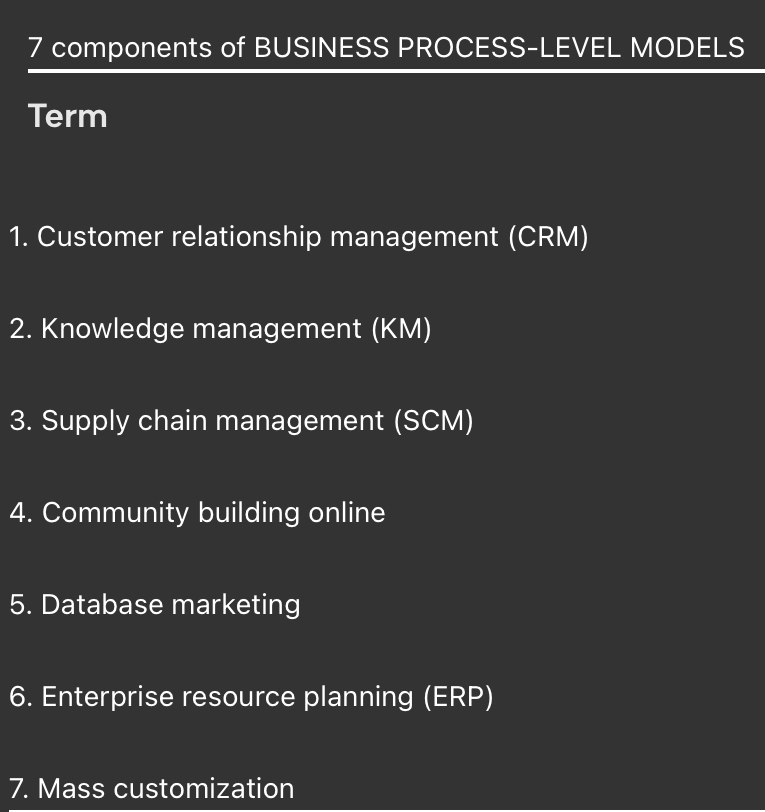
BUSINESS PROCESS-LEVEL MODELS
Community building online
firms build Web sites to draw groups of special interest users. Firms often gather e-mail lists of like-minded users from these communities for future e-mail marketing campaigns.
=> can create social bonds that enhance customer relationships.

Affiliate programs
when firms put a link to someone else's retail Web site and earn a commission on all purchases by referred customers.

BUSINESS PROCESS-LEVEL MODELS
Database marketing
involves collecting, analyzing, and disseminating electronic information about customers, prospects, and products to increase profits.
It is one of the fastest-growing strategies for e-marketers.

BUSINESS PROCESS-LEVEL MODELS
Enterprise resource planning (ERP)
refers to a back-office system for order entry, purchasing, invoicing, and inventory control.
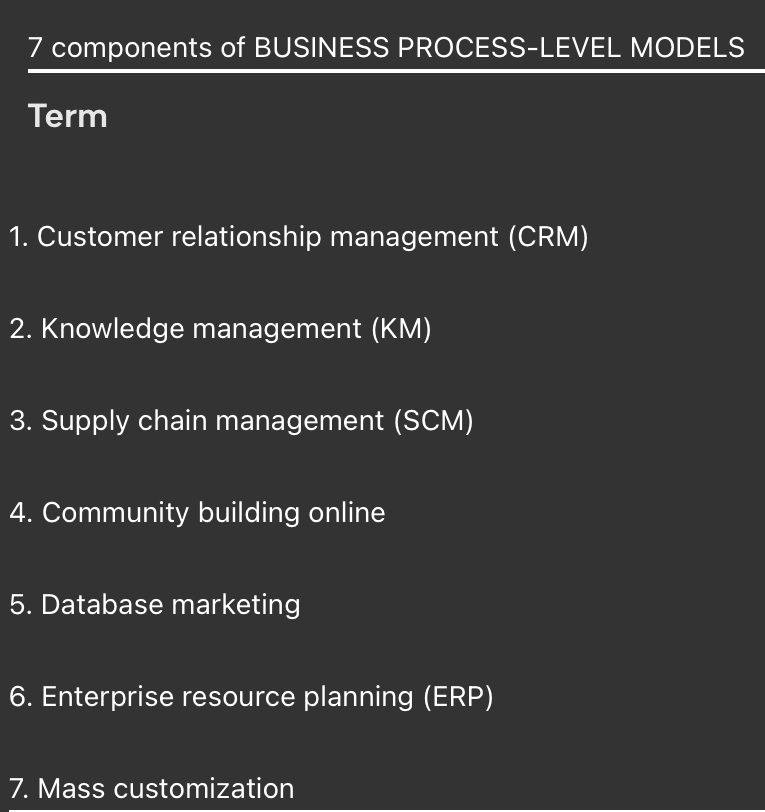
BUSINESS PROCESS-LEVEL MODELS
Mass customization
refers to the Internet's unique ability to customize marketing mixes electronically and automatically to the individual level.
Firms use this practice when they collect information from customers and prospects, and use it to customize products and communication on an individual basis for a large number of people.
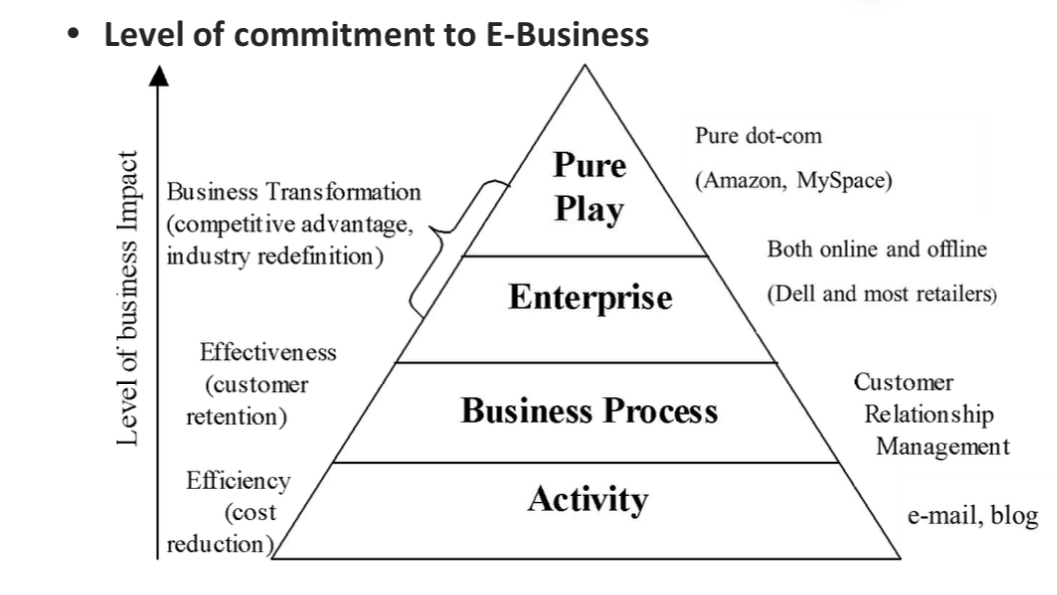
4 components of ENTERPRISE-LEVEL MODELS
1. E-commerce, direct selling, content sponsorship
2. Portal
3. Broker models
• Online exchange, hub
• Online auction
Agent models
• Manufacturer’s/selling agents
• Shopping agent
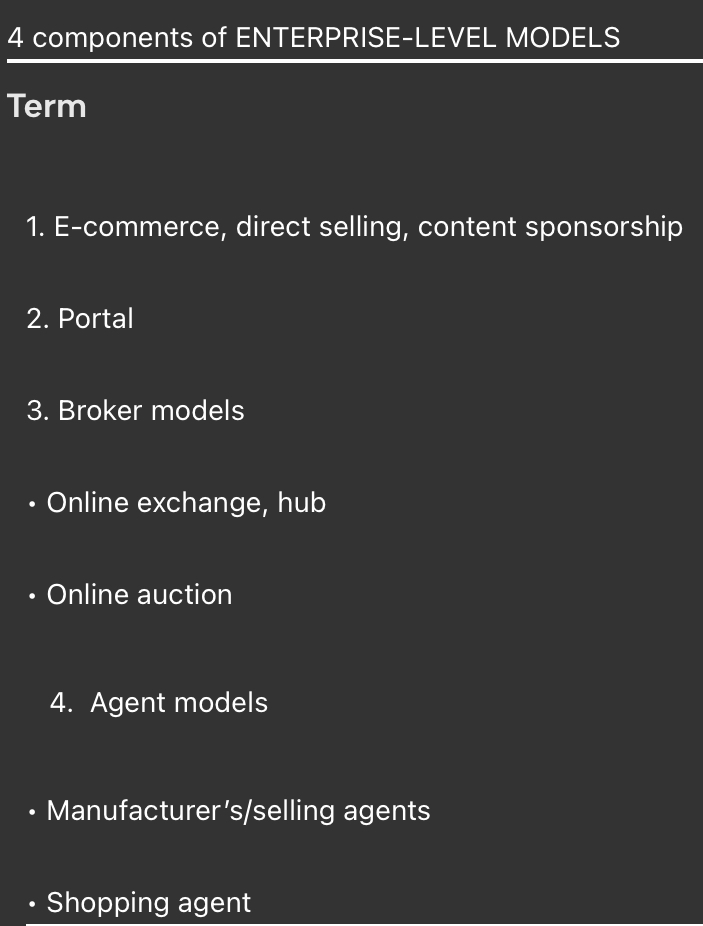
ENTERPRISE-LEVEL MODELS
E-commerce
refers to online transactions: selling goods and services on the Internet, either in one transaction or over time with an ongoing subscription price (e.g., Wall Street Journal Online).
Online retailers are
firms that buy products and resell them online
One type sells physical products and uses traditional transportation methods to deliver them.
The other type sells digital products such as media, software, and music and delivers them via the Internet (and usually ground transportation too).
Many maintain brick-and-mortar stores as well.
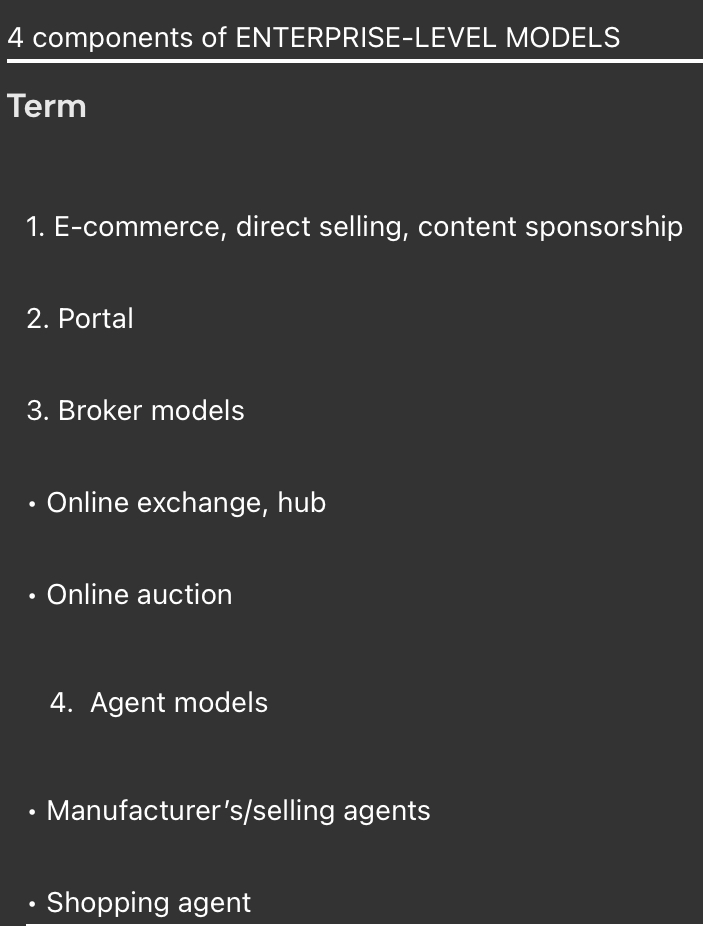
ENTERPRISE-LEVEL MODELS
direct selling
a type of e-commerce in which manufacturers sell directly to consumers, eliminating intermediaries such as retailers.
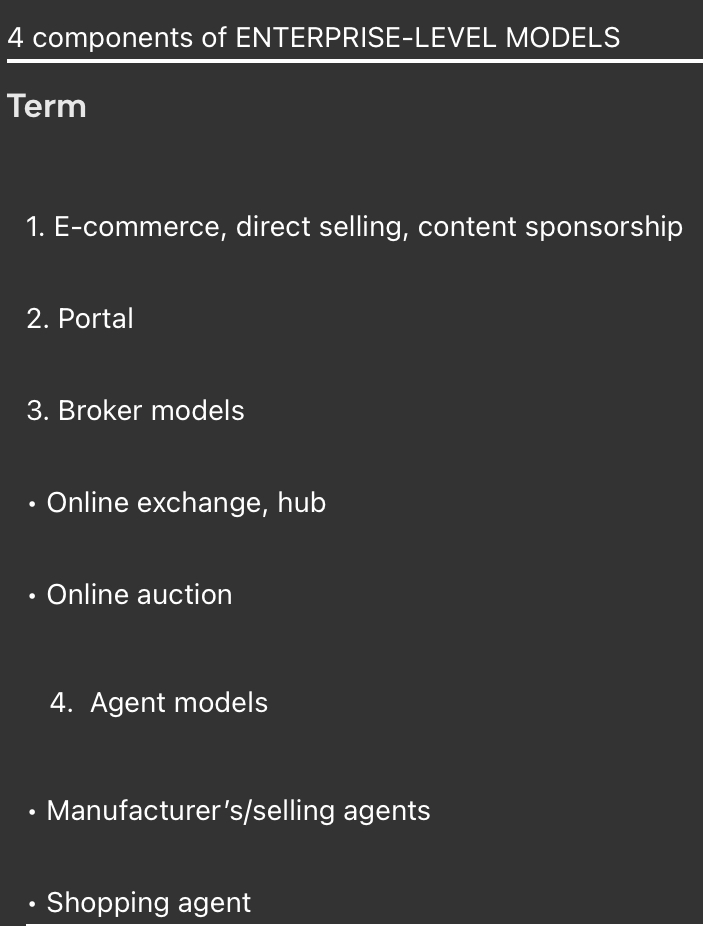
ENTERPRISE-LEVEL MODELS
content sponsorship online
a form of e-commerce in which companies sell advertising either on their Web sites or in their e-mail.
this model sprang from the media, which depend on advertising sales to pay for editorial content.
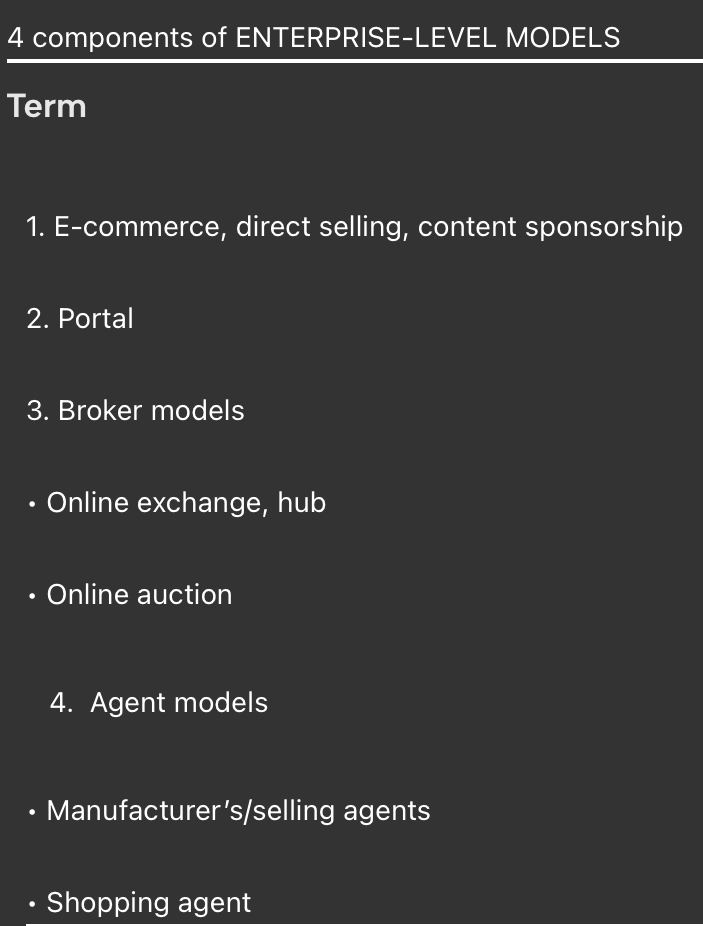
ENTERPRISE-LEVEL MODELS
Portal
point of entry to the Internet, such as the Yahoo! and AOL Web sites.
they provide many services in addition to search capabilities.
They include destinations for news, games, maps, shopping, … in addition to being jump-oft points for content provided by others
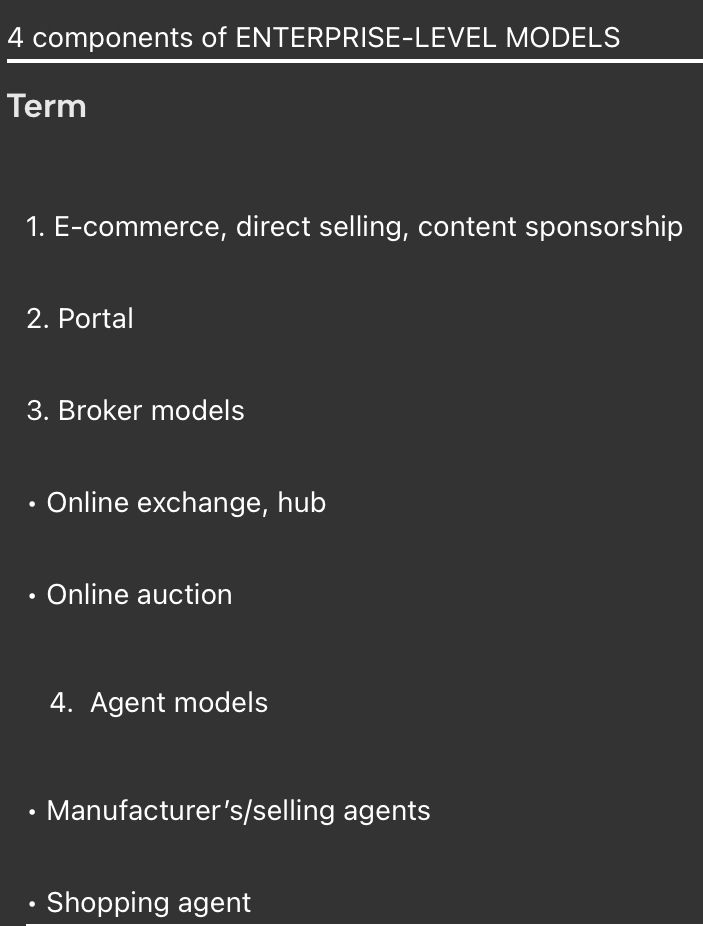
ENTERPRISE-LEVEL MODELS
Online brokers
intermediaries that assist in the purchase negotiations without actually representing either buyers or sellers.
The revenue stream in online brokers models is
commission or fee based.
online agents tend to
represent either the buyer or the seller and earn a commission for their work.
Manufacturer's agents represent …
more than one seller
In traditional marketing. they often represent manufacturing firms that sell complementary products to avoid conflicts of interest.
In the virtual world, they create Web sites to help an entire industry sell product.
the catalog aggregator
brings together many catalog companies to create a new searchable database of products for buyers.
A special type of agent is the metamediary
it represents a cluster of manufacturers, online retailers, and content providers organized around a life event or major asset purchase.
Consumets facing life events such as weddings or major asset purchases such as cars require a cohesive set of cognitively related products and information.
=> The metamediaries assemble all the content and services in one location for the customer's convenience and receive a fee from selling firms.
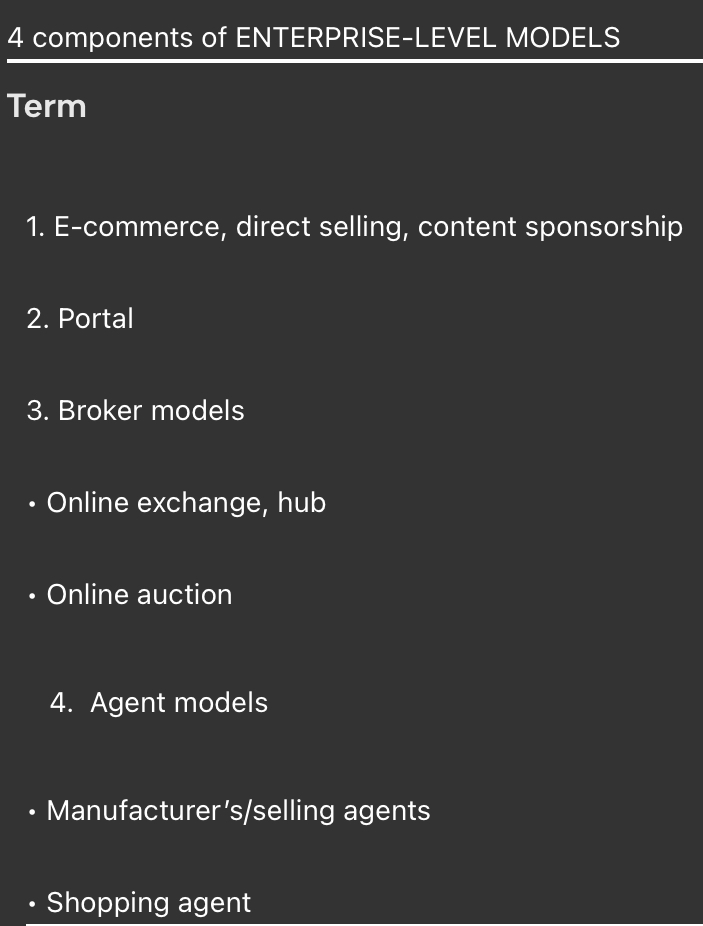
Purchasing agents represent ...
buyers
In traditional marketing, they often forge long-term relationships with one or more firms;
on the Internet, they represent any number of buyers, often anonymously.
the reverse auction allows …
individual buyers to enter the price they will pay for parficular items at the purchasing agent's Web site, and sellers can agree or not.
A virtual mall
It is similar to a shopping mall in which multiple online merchants are hosted at a Web site.
In this agent model, the firm with the Web site hosting the mall usually builds the site, promotes it, and takes a fee for its services.
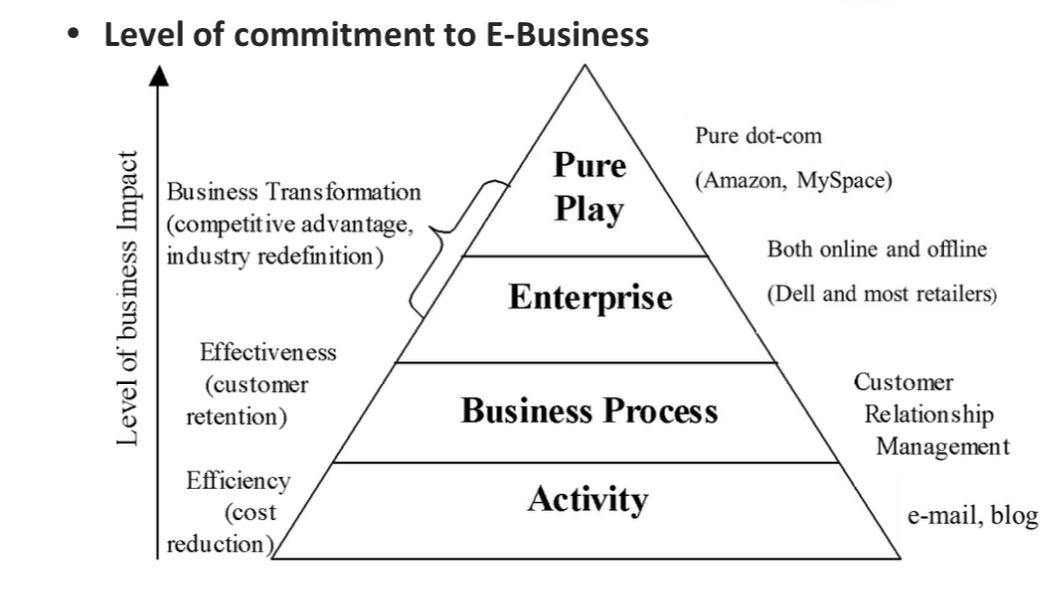
Pure plays
are businesses that began on the internet.
They represent the top level of the E-Business pyramid.
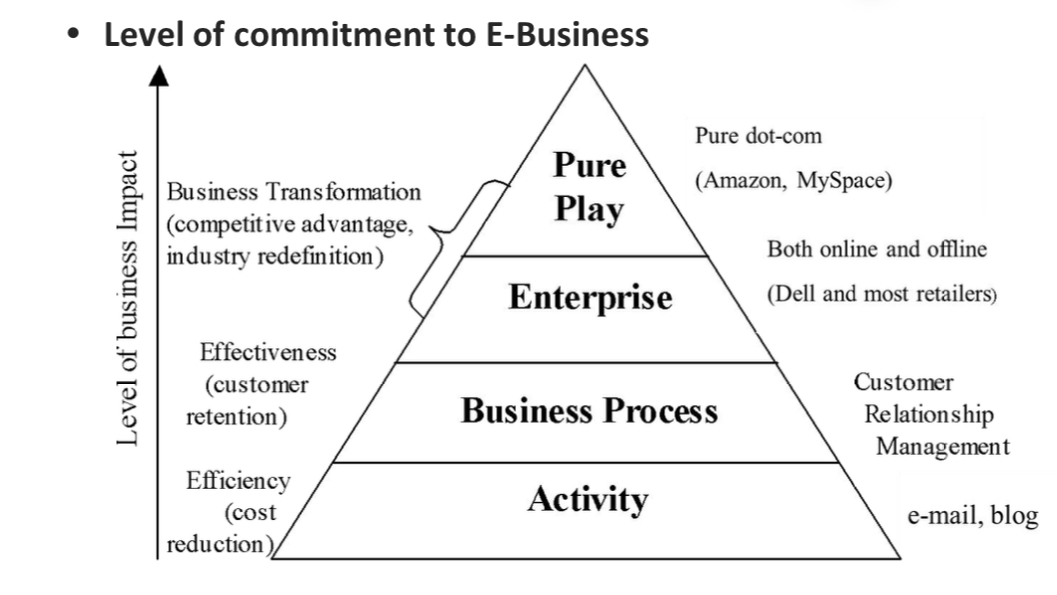
Pure plays face significant challenges.
• They must compete as new brands.
• They may need to take customers away from established businesses.
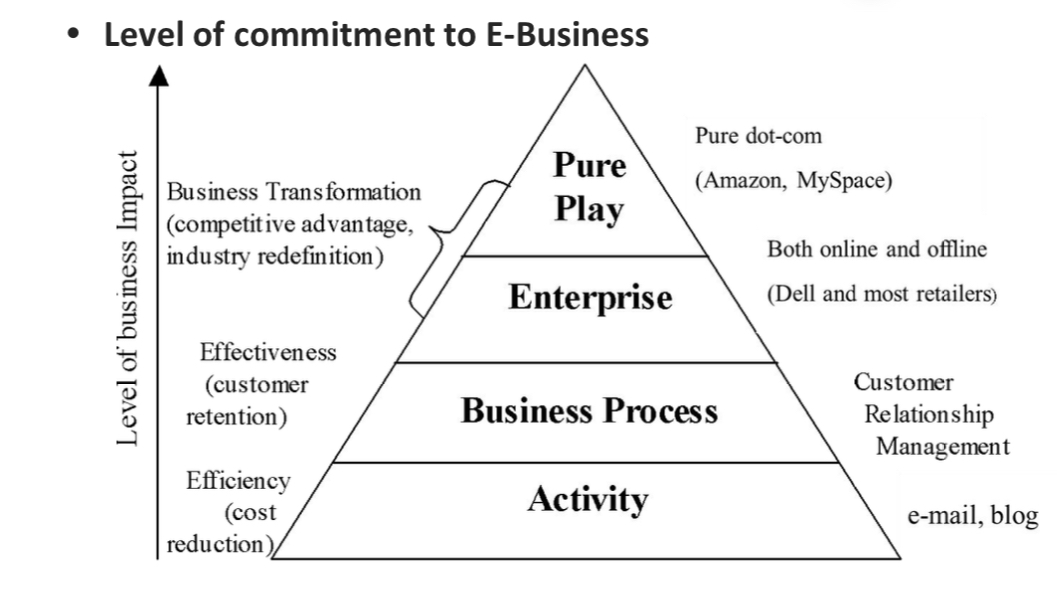
Some pure plays have redefined industries:
Ebay, Amazon, Yahoo!
Performance metrics
specific measures designed to evaluate the effectiveness and efficiency of operations.
Performance metrics must meet these conditions:
• Provide measurable outcomes.
• Must be easy to understand and use.
• Must be actionable.
• Can be utilized for employee evaluations.
Web analytics, commonly called metrics, is
the study of user behavior on Web pages
Web analytics/ Metrics measure activities such as:
• Click throughs
• Visitor patterns
• Length of time spent on a page or site
• Conversions to sales
Web analytics software helps companies analyze …
data on server
Online measurement also includes metrics for evaluating Web … technologies.
2.0
Social engagement metrics allow marketers to know
how visitors participate, not just whether they landed on a page:
Time spent viewing a video, playing a game, or listening to music.
Writing a comment on a post.
Downloading a video, picture or other
The Balanced Scorecard (BSC)
a strategic management tool developed by Robert S. Kaplan and David P. Norton.
It helps organizations translate their vision and strategy into actionable objectives by providing a framework for measuring performance beyond traditional financial metrics.
The Balanced Scorecard provides … perspectives.
4 perspectives
o Customer perspective
o Internal perspective
o Learning and growth perspective
o Financial perspective
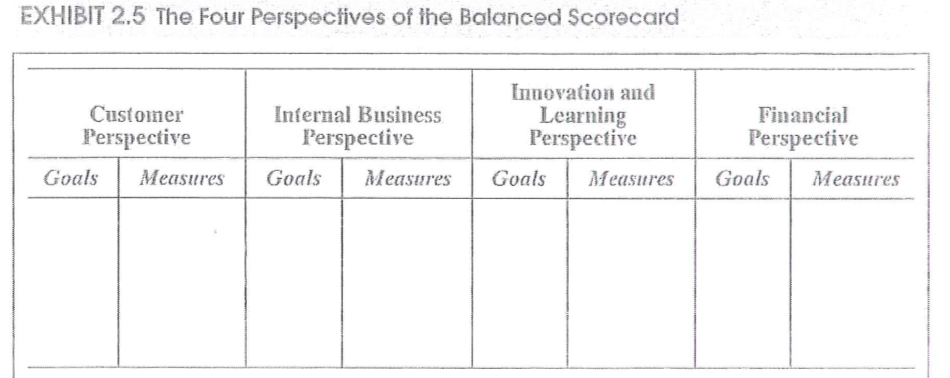
THE BALANCED SCORECARD:
Customer Perspective
includes ways to measure goals such as customer loyalty, satisfaction, frequency of of online sales, etc.
• Loyalty and satisfaction measures may include percentage of visitors who return to site and time between visits.
• Transaction measures may include measurement of unique visitors, online sales abandoned, etc.
THE BALANCED SCORECARD:
Internal Perspectives
includes ways to measure goals related to the the efficiency and effectiveness of internal processes to ensure operational excellence
• Quality of online technical help can be measured by the number of people who use the service, Web page loading time
• Optimized inventory levels can be measure by the supplier speed to deliver the product, inventory turnover
THE BALANCED SCORECARD:
Learning and Growth Perspectives
includes ways to measure goals related to online service innovation and continuous improvement.
• Online service innovation can be measured by number of new service/products to market a year, percent of sales from new services
THE BALANCED SCORECARD:
Financial perspectives
includes ways to measure financial goals.
• Increase market share for online products can be measured by Sales growth and market share percentage
• Increase net profit can be measured by net profit as percentage of sales
THE BALANCED SCORECARD
Implementation Steps
5 steps:
1. Define organization's Vision and Strategy
2. Develop Objectives: Create specific, measurable objectives for each of the four perspectives.
3. Select KPIs:
4. Set Targets: Establish performance targets for each KPI.
5. Monitor and Review:
